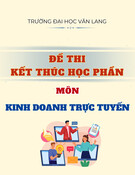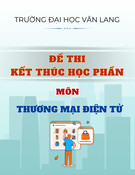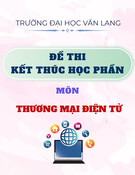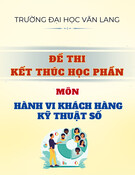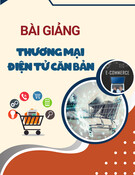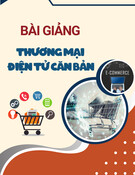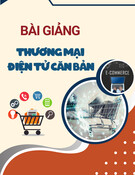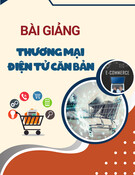
Proceedings of the 4th International Conference on Business & Social Sciences (ICOBUSS) 1233
Surabaya, October 26-27th, 2024
THE EFFECT OF FEAR OF MISSING OUT (FoMo), HEDONIC
SHOPPING, AND ONLINE SHOPPING ANXIETY ON PURCHASING
DECISIONS
Devi Yolanda Oktavia*,
1Faculty of Economics and Business, Narotama University, Surabaya, Indonesia
*Corresponding Author:Oktaviadevi05@gmail.com
Abstract: The purpose of this study was to determine 1) the extent to which Fear of Missing Out (FoMO)
influences purchasing decisions at TiktokShop, 2) the extent to which Hedonic Shopping influences purchasing
decisions at TiktokShop, and 3) the extent to which Online Shopping Anxiety influences purchasing decisions at
TiktokShop. 4) the extent to which Fear of Missing Out (FoMO), Hedonic Shopping, Online Shopping Anxiety
influence purchasing decisions at TiktokShop. In this study, the number of samples used as samples using Google
Form was 180 people. A statement scale questionnaire was used to collect data in this study. The results of the T-
test (partial) study showed that Fear of Missing Out was indicated by a significance value of 0.000 <0.05), Hedonic
Shopping significance value of 0.002 <0.05, Online Shopping Anxiety significance value of 0.000 <0.005. This
study shows that Fear of Missing Out (FoMO), Hedonic Shopping, Online Shopping Anxiety have a significant
influence on the purchasing decisions of Narotama students at TikTok Shop, with an impact value of 64%.
Keywords:Fear of Missing Out (FoMO), Hedonic Shopping, Online Shopping Anxiety, Purchase decisions
_________________________________________________________________________
1. Introduction
The Covid 19 pandemic has passed, but there is one habit that is still left behind and is still
carried out by the Indonesian people, namely online shopping. This is supported by several E-
commerce that have emerged by offering many promotions that have made the Indonesian
people switch to online shopping compared to offline shopping, for example, Tiktok Shop.
Since 2020, e-commerce in Indonesia has continued to increase. In 2023, the increase in e-
commerce in Indonesia will reach 21.56%. This is estimated to continue to increase to 34.84%
in 2029. (Central Statistics Agency, 2023). Household and Fashion Products are the most
popular commodities. Throughout Semester I 2023, Bank Indonesia recorded that the
realization in 2023 reached 3.49 billion (Bank Indonesia, 2023)
TikTok is currently a popular social media not only among Indonesian people but also
throughout the world. Various interesting features provided by the TikTok application make
TikTok a social media that is widely used not only in Indonesia but throughout the world. It is
certain that in 2023, there will be 99.1 million TikTok users in Indonesia, making Indonesia
the second country in the world with the most TikTok users (source wearesocial.com).
According to Adawiyah from Hellen Juliana (2023), the TikTok application has won an award
as one of the entertainment applications on the Playstore. One of the features or services
provided by TikTok is TikTok Shop.
The appeal of FoMO can increase the likelihood of making a purchase, and as a result
individuals expect positive emotions to arise after individuals reduce anxiety associated with
FoMO, and this can increase pleasure in purchasing (Mandel & Nowles, in Goode & Hyman,
2021). According to research conducted by Yaputri et al., (2022), the higher the level of FoMO

Proceedings of the 4th International Conference on Business & Social Sciences (ICOBUSS) 1234
Surabaya, October 26-27th, 2024
felt by a person, the higher the consumer behavior carried out by the individual. FoMO is a
form of emotion that affects everyday life, and we unconsciously feel it on various occasions.
For example, when we scroll through the Tiktok application we see interesting items and when
we see a yellow basket there is a discount, and the fear of missing out on discounted items is
one form of FoMO. From this, researchers are interested in conducting research on the effect
of fear of missing out on consumer behavior among female students who make discounted
purchases on the Tiktok Shop application.
From the existence of the Tiktok application there are severalan interesting phenomenon,
namely a new trend that causes fear of being left behind x information or trends. Przybylski et
al., (2013) defines Fear of Missing Out (FoMO) as anxiety that occurs due to fear of being left
behind when other people experience various things such as impressive experiences while an
individual does not feel it which then arises the desire to always be connected or follow what
happens on social media. The urge to always be connected to anyone, especially friends and
other people in any way is a characteristic of this Fear of Missing Out (FoMO). The desire to
feel, follow, and always be updated with various things on social media makes someone can
be indicated as experiencing Fear of Missing Out. The factors that cause someone to experience
Fear of Missing Out according to JWT Intelligence in Sianipar & Kaloeti, (2019) are the
openness of information on social media.
Apart from Fear of Missing Out (FoMO) there is also a trendHedonic Shopping can influence
the decision to purchase goods because consumers have certain motives that influence their
actions. Some people shop because it is fun, and they believe that shopping is interesting.
Consumer purchasing activities may reflect emotional values, such as elements of satisfaction
and pleasure. There are many reasons why someone tends to make hedonic purchases,
especially because their previous needs have not been met. After these needs are met, new
needs arise, which are sometimes higher than previous needs. Hedonic shopping motives also
occur when someone has a desire to shop that is easily influenced by the latest trends or
promotions and discounts for a limited time. Therefore, individuals often make impulsive
purchases because they are driven by satisfaction and pleasure when shopping and are
motivated by the opportunity to receive facilities and special offers from products.
However, many people feel anxious when shopping online. Consumer anxiety when buying
products online makes e-commerce parties have to develop strategies to minimize consumer
anxiety when buying products through e-commerce. This method is intended to facilitate the
implementation of various e-commerce functions. Consumers do not need to waste time
learning e-commerce, thereby increasing their intention to buy products online (Istanti, 2017).
This is inseparable from the advantages of e-commerce itself, such as saving time, energy, and
significant costs in finding the desired product. The greater the benefits felt by consumers, the
greater their desire to shop online (Khairunnisa et al., 2018). Based on the above phenomenon,
researchers want to further examine the InfluenceFear of Missing Out (FoMO),Hedonic
Shopping, AndOnline Shopping Anxiety on Purchasing Decisions.

Proceedings of the 4th International Conference on Business & Social Sciences (ICOBUSS) 1235
Surabaya, October 26-27th, 2024
2. Literature Review
FoMO (Fear of Missing Out)
Zhang (2020) defines FoMo as a feeling of discomfort that arises due to missing something
that then makes someone feel left behind. Meanwhile, if viewed from a broad meaning, FoMO
(Fear of Missing Out), is defined as "understanding a broad area where someone might
experience someone's absence. Thus, FoMO can refer to the discomfort felt when seeing other
people looking happier so that they feel greater satisfaction (Afdal et al., 2018). FoMO is often
characterized by a desire to stay connected with what others are doing, especially through social
networking sites (SNS) (Beyens et al., 2016). 2018) stated that FoMO is a widespread concern
due to the fear of experiencing positive big stories and events that others cannot follow, it It is
recommended to monitor social media so that similar incidents do not happen again.
Hedonic Shopping
Hedonic shopping behavior is consumer behavior that is influenced by various factors and
indicates purchasing behavior for hedonic purposes. In addition, there are other factors that
trigger purchasing behavior to fill free time, search for products, and fulfill fantasies (Utami,
2017:60). Gultekin & Ozer 2016 (Syafri & Besra, 2019) found that in consumer behavior,
consumers are motivated to shop because they feel happy when they get the products they want.
According to Pasariu's research in 2015 (Purnamasari et al., 2021)). Hedonic shopping motives
are consumer shopping behavior driven by hedonic motives, influenced by factors such as
imagination, economy, and developments in fashion trends. Various trends that continue to
develop in society have the potential to influence the continuation of consumer purchases.
Online Shopping Anxiety
Research conducted by Silaban (2022) defines anxiety as a feeling of worry experienced by
someone when experiencing things that they consider to be obstacles or facing difficult
situations. Srinivasan (2015) in Dewi et al. (2020) explains that online shopping anxiety is part
of the negative feelings experienced when shopping online. Meanwhile, Nagar (2016) explains
that if consumers are afraid of not receiving products purchased online, it will cause anxiety.
Furthermore, according to Celik (2016), online shopping anxiety refers to the extent to which
consumers experience anxiety when shopping online. Consumers feel more anxious about
online shopping transactions and it is possible that some consumers try to refrain from shopping
online because they experience difficulties in logging in, shipping problems, payment
procedures, and incomplete product information (Nagar & Gandotra, 2016; Vijayasarathy,
2004) . This is in line with Dewi et al. (2020) that anxiety refers to consumers' fear of the
products they buy because some consumers do not understand the characteristics of e-
commerce.
Buying decision
Astutik et al. (2022) define purchasing decisions as a choice between two or more alternatives.
This means that before making a purchase, a person has several choices and must choose one
of them. According to Kotler (2016), purchasing decisions are part of consumer behavior, and
consumer behavior is defined as how individuals, groups, and organizations choose, buy, and
use products, services, and ideas, concerning how experiences satisfy needs and wants.

Proceedings of the 4th International Conference on Business & Social Sciences (ICOBUSS) 1236
Surabaya, October 26-27th, 2024
Purchasing decisions are a stage in the decision-making process where consumers actually
make purchases (Setyawati et al., 2021).
Framework of Thinking
Hypothesis
H1: There is an InfluenceFear Of Missing Out (FoMo) On Purchasing Decisions
H2 :There is InfluenceHedonic Shopping on Purchasing Decisions
H3 :There is InfluenceOnline Shopping Anxiety on Purchasing Decisions
H4 :There is InfluenceFear Of Missing Out (FoMo), Hedonic Shopping, Online Shopping
Anxiety on Purchasing Decisions.
3. Method
The research approach used by the researcher is a quantitative approach. The purpose of
quantitative research is to determine the relationship between variables in a population. There
are two types of quantitative research designs, namely descriptive and experimental.
Descriptive quantitative research only takes measurements once. Quantitative data is in the
form of questionnaire data from respondents. According to Sugiyono (2014), quantitative
research methods can be interpreted as research methods based on the philosophy of positivism,
used to research certain populations or samples. Sampling techniques are generally carried out
randomly, data collection uses research instruments, data analysis is quantitative or statistical
in nature with the aim of testing previously established hypotheses. Data collection in this study
was through the distribution of questionnaires. Primary data was collected specifically by
researchers to obtain answers to questionnaires distributed to selected respondents.
The population in this study were Narotama students who had shopped at Tiktok Shop. The
determination of the number of samples in this study used the quota sampling technique which
is a type of purposive sampling. Quota sampling is a technique for taking samples with an
unknown population size with certain criteria until the desired quota is met according to the
Hedonic
Shopping (X2)
Online Shopping
Anxiety (X3)
Keputusan
Pembelian(Y)

Proceedings of the 4th International Conference on Business & Social Sciences (ICOBUSS) 1237
Surabaya, October 26-27th, 2024
specified strata (Kriyantono, 2010). According to Hair et al (2017) in (Triandewo & Yustine,
2020). the determination of the minimum number of samples that should be used is 10 times
the total number of latent variables arrows in the path model or 10 times the number of
indicators. Based on these guidelines, it can be calculated: Minimum sample = 10 x 18 = 180
respondents. The minimum sample used was 180 respondents.
4. Conclusions
Table 1 Normality Test
Variables
Sig
FoMo
0.000
Hedonic Shopping
0.000
Online Shopping Anxiety
0.000
Purchase Decision
0.079
The results of the normality test show that the asymp. Sig. (2-tailed) or probability value is
0.079. This shows that the significance value produced is greater than 0.05 (0.079 > 0.05) as
required. So it can be concluded that the data in this study are normally distributed.
Table 2 Multilinearity Test
Model
Collinearity Statistics
Tolerance
VIF
1
Hedonic Shopping
,433
2,309
Online Shopping Anxiety
,553
1,808
FoMo
,695
1,439
a. Dependent Variable: Purchase Decision
The results of the analysis test showed that there were no symptoms of multicollinearity
between Fear of Missing Out, as indicated by a tolerance value of 0.433.Hedonic
Shoppingindicated by a tolerance value of 0.553, and Online Shopping Anxiety of 0.695 >
0.100 and Fear of Missing Out has a VIF value of 2.309 < 10.00,Hedonic ShoppingHas a VIF
value of 1.808 < 10.00and Online Shopping Anxiety Has a VIF value of 1.439 < 10.00.
Table 3 Linearity Test
F
Sig
(combined)
17.399
0.000
Decision
Making
Between Groups
Linearity
144.397
0.000
Deviation From Lineartiy
0.152

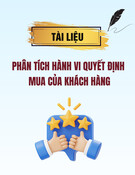
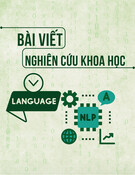






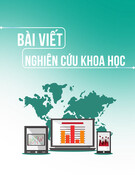

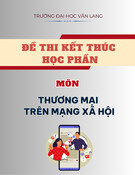
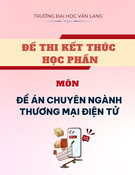
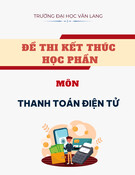
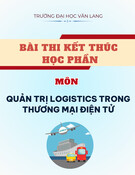
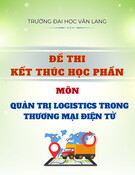
![Đề thi Chiến lược thương mại điện tử học kì 2 năm 2024-2025: [Có thể thêm thông tin chi tiết về trường/lớp]](https://cdn.tailieu.vn/images/document/thumbnail/2025/20251007/kimphuong1001/135x160/60231759811243.jpg)
